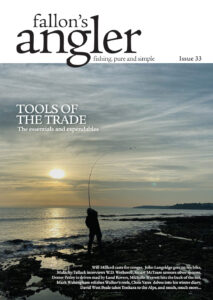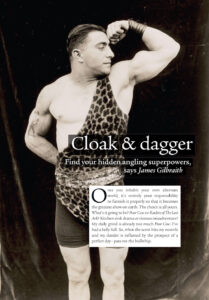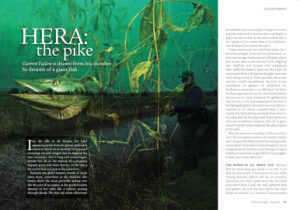It is nearly a decade since ‘Fallon’s Angler’ first finned its way onto our bookshelves, and in that time it has continued to challenge the mainstream narrative. Blooding new voices alongside the long-time revered, each issue looks to search a little bit deeper beneath the surface. Deputy editor Kevin Parr introduces us to Issue 33 — ‘Tools of the Trade’, which is out now.

‘Can I ask you something?’ Ollie had a note of concern to his tone.
‘Of course,’ I offered warmly, although I suspected what might be coming.
‘Are you actually enjoying what you are doing? Please don’t take it the wrong way, but I’m struggling to see how you can be.’
I chuckled and tried not to kid myself. Was I enjoying this?
The hotspot was the size of a kitchen table, and I needed to cast behind and beyond it so the flow from the sidestream opposite could carry my bait over the shallower shelf before dropping it into the honeypot. I had nearly ten feet between hook and float and was attempting the cast with a centrepin into a stiff, swirling breeze, trying to avoid an alder overhang and a trail of willow that helped create the crease. I was hitting the right spot less than one cast in ten, at which point my under-gunned float (which was the biggest I had brought) would get swept and swamped by the clashing currents. I had, somehow, managed to catch three roach, but Ollie would expect a fish a cast.
‘Go on then,’ I conceded, ‘show me how it’s done.’
Ollie fetched a rod from his truck, a light, carbon blank with a small, fixed-spool reel attached. His float was huge, but sailed across the river with a gentle cast and then bossed the current it sat in. A 6-ounce dace came on Ollie’s first cast and set the pattern for the next 20 minutes. Roach and grayling grabbed the bait if the dace missed it, before a long, lean 4lb chub added some excitement and prompted Ollie to offer me the rod.
‘Go on, Kev. You know you want to…’
I did, and suddenly the fishing was easy — well, straightforward at least. I still had to find a rhythm, mend the line and hit the lightening quick bites, but I was enjoying it more than I had been and had to ponder why I had resisted the change for so long. This was Ollie’s angling backyard, a stretch of river he knew as well as anyone, and he is an angler with an extraordinary ability for catching fish. He had told me the best way of fishing this swim before I had even seen it and yet I persevered with my own course. Our conversation, inevitably, focussed on my process.

Yes, I can be stubborn and am stolidly resistant to change, but in this instance my failing had in part evolved from a shift in value. There was a time when I needed to catch fish. A big barbel on a Sunday evening could spur me through the stress of a working week. Yes, I would take relief from the riverside and all the well-worn cliches that we spin to non-anglers to convince them that there really is more to fishing than catching fish. But nothing, actually, compared to catching something monstrous. Not in the soul-searching aftermath, in the thick of spreadsheets and a bottomless inbox.
Today, though, those cliches have foundation. Fishing still offers a connection to water, to its fascination and complexity, but I don’t always need a rod as a conduit and often I am better equipped with no rod at all. Time and achievement were constraints I placed upon myself, and without their weight I breathe ever deeper. I am a pleasure angler. I’ll never be able to fish whenever I want, but I have learned to not fish when I want.
So, too, has developed a value of things. Of a favourite rod, reel or float. I like the weight and familiarity, the value of continued use. The sense of nostalgia. Nothing overtly rose-tinted, but more an ergonomic comfort, of sinking into a favourite chair or your own bed.
On the bank of the River Test, Ollie offered me a reminder that there is no right or wrong way to fish. And that I could let go of the familiar and feel more at ease. A Phillips is not going to loosen a flathead screw, no matter how long you have had it.
For Issue 33 of Fallon’s Angler we explore the tools of the trade, those things expendable or essential, with function or dysfunction. And the idiosyncrasies that fill every angler’s tackle bag.
